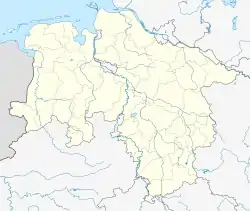Sögel | |
|---|---|
 Flag  Coat of arms | |
Location of Sögel within Emsland district  | |
 Sögel  Sögel | |
| Coordinates: 52°51′N 07°31′E / 52.850°N 7.517°E | |
| Country | Germany |
| State | Lower Saxony |
| District | Emsland |
| Municipal assoc. | Sögel |
| Government | |
| • Mayor | Heiner Wellenbrock (CDU) |
| Area | |
| • Total | 55.2 km2 (21.3 sq mi) |
| Elevation | 35 m (115 ft) |
| Population (2021-12-31)[1] | |
| • Total | 8,210 |
| • Density | 150/km2 (390/sq mi) |
| Time zone | UTC+01:00 (CET) |
| • Summer (DST) | UTC+02:00 (CEST) |
| Postal codes | 49751 |
| Dialling codes | 0 59 52 |
| Vehicle registration | EL |
Sögel is a municipality in the Emsland district, in Lower Saxony, Germany. Sögel is most known for the Clemenswerth Palace, a hunting lodge built 1737-1749 by Johann Conrad Schlaun for Elector Clemens August.

Clemenswerth Palace
Personalities
Born in Sögel

Catharina Busch
- Wilhelm Röpke (1873-1945), surgeon in Wuppertal, president of the German Society of Surgery
- Bernhard Rakers (1905-1980), Nazi war criminal
Died in Sögel
- Katharina Sibylla Schücking (1791-1831), poet
- Johann Heermann (1897-1976), politician, MdL
World War II
Much of the centre of Sögel was deliberately destroyed by the Canadian Army after the town was captured in April 1945.
References
This article is issued from Wikipedia. The text is licensed under Creative Commons - Attribution - Sharealike. Additional terms may apply for the media files.